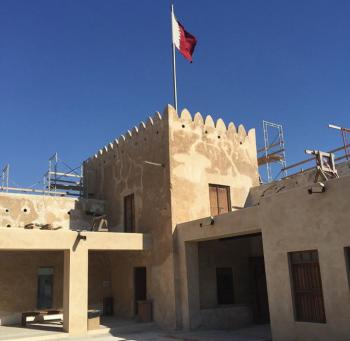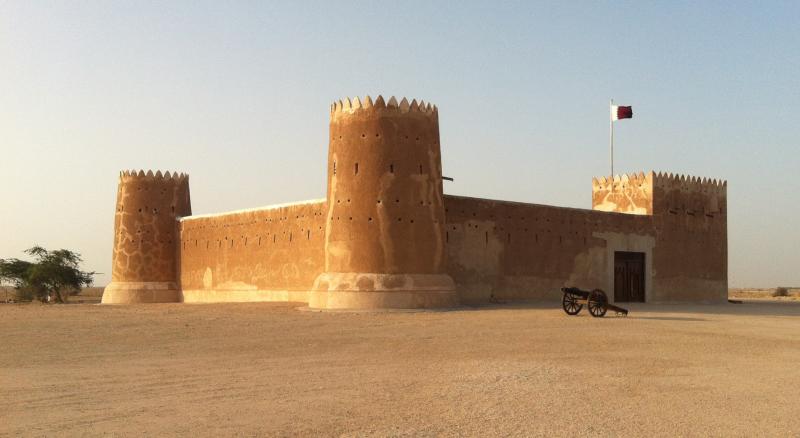Across the ages — expedition into the Qatari Desert
This item appears on page 55 of the September 2016 issue.
It is not often that you have the opportunity to experience 5,000 years of archaeology in just eight hours. In March 2016, my husband, Paul, and I visited Qatar, a small country roughly the size of Connecticut that juts out into the Persian Gulf. It shares a land border only with Saudi Arabia to the south.
Most visitors travel to Qatar for business. If they go for pleasure, as we did, it is for Qatar’s futuristic architecture, glittering mega-malls, atmospheric souks and beaches. No one I spoke to — in advance of the trip or during it — mentioned archaeological exploration. In fact, even my repeated email inquiries to Qatar’s tourism office regarding archaeology met with no response.
We were lucky to find a company, Qatar International Adventures, that offers tours in Doha, Qatar’s capital, and throughout the country. They were able to provide us with a private car plus a driver and a guide for a day-long excursion to visit archaeological sites.
Desert towers
Our archaeological trek began at the Barzan Towers, located in the town of Umm Salal Mohammed, about 11 miles north of Doha. There stand two picturesque towers, one with external staircases and the other with cone-shaped buttresses clinging to its sides like barnacles.
Both towers are constructed of coral stone blended with limestone which is then plastered over. Built in the late 19th century and restored in 1910 by Sheikh Mohammed bin Jassim Al Thani, these towers served several purposes: as watchtowers to track approaching Gulf trade ships and as lookouts for Ottoman enemies.
Farther along Qatar’s east coast, our guide, Sameh Mohamed, took us to the deserted village of Al Jumail, one of many such villages dotting Qatar. Originally built in the 19th century, possibly atop an earlier settlement, Al Jumail was once a fishing village. It was abandoned after the discovery of gas and oil, the source of Qatar’s present wealth.
Al Jumail is now a crumbling maze of houses and one mosque, its minaret still intact. We had read that the Qatari government is considering restoring Al Jumail into an open-air museum with costumed “interpreters” — an excellent idea, we felt.
Jebel petroglyphs
Our next stop was Al Jassassiya, near the northeastern tip of Qatar. I thought this would be the highlight of our excursion. It was.
On parallel limestone hills called jebels are hundreds of well-preserved petroglyphs as well as double rows of shallow holes. The petroglyphs include dhows, which are traditional sailing ships with triangular sails, as well as footprints and various animals.
What Sameh saw as a fish with fins, I saw as a boat with multiple oars on either side. Paul thought these carvings looked like scorpions scampering over the rocks. One of the delights of archaeological “interpretation” is that everyone can have an opinion.
The double row of holes could have been a game called mancala (also called haloosa or huwaila), although why there were so many of these rows, often very close to each other, is anyone’s guess. This was once an important pearl-diving area, and it could be that this was the way pearl divers relaxed when not diving for oysters.
What is also uncertain is the age of the site. Some sources say four to six thousand years old. Highly unlikely. Some claim they are 600 years old, based on pottery found in ruins of nearby dwellings. Maybe. The best estimate based on radiocarbon dating is that these carvings date from about the middle of the 18th century.
On the way to Al Zubarah, another of the trip’s highlights, we stopped at Al Rakiyat Fort, built in the 18th or 19th century for defense and to protect the water source.
This utilitarian-looking fort with few decorative elements is rectangular in shape, with towers at each corner, three rectangular and one circular. There are narrow rooms lining three sides that were once living quarters for soldiers.
In contrast, Al Thaqab Fort, only a mile and a half away, has beautiful decorative details. It too is rectangular, with four corner towers (three round and one rectangular, but it has beautifully constructed wooden doors, rooftop crenellations and interior arches that add beauty to an otherwise functional construction.
UNESCO World Heritage Site
In 2013, Al Zubarah became Qatar’s first UNESCO World Heritage Site. Located 63 miles northwest of Doha, it consists of a fairly recent (1938) fort and a much older ruined city beside it.
The fort is easy to visit. The Old City is not. Al Zubarah Fort, like Al Rakiyat and Al Thaqab forts, is rectangular in shape, with four corner towers. There are one rectangular and three circular towers with external staircases leading up to a walkway within the fort’s wall from which soldiers could patrol.
The rooms around the courtyard that were once military barracks are now a small museum displaying artifacts found in the ruins of the adjacent city.
Al Zubarah Fort is open from 8 to 6 Sunday to Thursday and from early afternoon to 6 on Friday; it’s closed on Saturday. There is no admission charge.
From photographs I had seen, the Old City of Al Zubarah looked intriguing. There were many fortified trading towns along the Qatari coastline from the early years of Islam. Al Zubarah was one of them.
The town grew and flourished for only about 50 years, from about 1760 until it was destroyed in 1811. In its brief life, it thrived on fish, pearls and trade. The city was extensive, with an estimated population of about 6,000. There were palatial houses, courtyard houses, fishermen’s huts, souks, mosques and a harbor. Protective walls with watchtowers surrounded them all.
Excavations have been underway since 2009. The site is currently closed to visitors, although my advance research had indicated that it was visitable, supposedly with a pathway leading to one of the excavated areas. Not so, according to the site caretaker on the day we visited.
Dilmun burial mounds
Perhaps the most intriguing and mysterious site of the day was the last, the Umm Sala Ali burial mounds that we visited on our way back to Doha.
Located close to the Barzan Towers we had seen at the beginning of the day, these small burial mounds are reputedly four to five thousand years old. They could possibly date back to the Dilmun culture that flourished in the Persian Gulf from about 3200 BC and that was conquered by the Babylonians about 600 BC.
The people of this culture were great traders, so it is no surprise to find burial mounds in Qatar, since Dilmun encompassed Bahrain, Kuwait and eastern Saudi Arabia as well as Qatar.
There is a building boom going on in Doha. Umm Sala Ali is only 17 miles outside the capital, with, we were told, a mega-mall currently being built in the vicinity of the burial mounds.
A locked fence surrounded the building site when we visited. Within the fenced-in area lay the burial mounds, looking figuratively stranded in time. It is hoped that they will be protected and preserved and not haphazardly incorporated into the mall. Mounds from the fourth millennium BC are much rarer than mega-malls in Qatar.
With the exception of this last site, all the sites we visited appeared to be open and accessible all day long. There were no posted hours except at Al Zubarah.
Museum of Islamic Art
A “must see” for any trip to Qatar is the superb Museum of Islamic Art (www.mia.org.qa), designed by Chinese-American architect I.M. Pei.
Fourteen hundred years of Islamic art is displayed in a strikingly modern building constructed on an artificial island just off the Corniche. It deserves a visit of at least two hours. More would be better.
If you go…
Qatar International Adventures (Al-Rawabi Street, Al Muntazah Building #16, 1st Floor, Office #07, Doha, Qatar; phone 974 4455 3954, www.qia-qatar.com) arranged our day-long archaeological excursion at a cost of $412 for car, driver and guide. We recommend them highly.
We think it would be a mistake to attempt this trip in a self-drive rental car because most of these sites are not easy to find on your own.
We’ve always loved Shangri-La hotels and have stayed in them wherever we find them, including on our many trips to Hong Kong, Singapore and Bangkok, so we were delighted to hear that a Shangri-La had just opened in Doha.
We spent six nights in this newest addition to the Shangri-La family, located in the West Bay area of Doha, where so many of the city’s fabulous skyscrapers are located. From our Horizon Club-level room on the 39th floor, we had a front-row view of the nightly light show (sunset to 11 p.m.) on two buildings across from us plus a glimpse of the Persian Gulf.
If you can, upgrade to the Horizon Club, which includes a complimentary buffet breakfast in a private lounge plus all-day free beverages. A great evening snack buffet (also gratis) is offered daily from 5:30 to 7:30 with wines, liquor and soft drinks.
If staying in a non-Horizon room, you’ll still enjoy low-key elegance. Non-Horizon rooms may include breakfast, depending on the room rate selected.
At the Shangri-La Hotel, Doha (Conference Centre St., West Bay, P.O. Box 9282, Doha, Qatar; phone 974 4429 5000 [Qatar] or, from the US, 866/565-5050, www.shangri-la.com/doha/shangrila), prices for rooms range from $273 to $460 per night. There are also 2- and 3-bedroom apartments beginning at $686 per night, if you’re traveling with family or friends.
There are also restaurants on site for lunch or dinner. We dined twice at the Argentinian restaurant Fuego and at the Sridan Restaurant, the latter of which offers a Middle Eastern buffet as well as à la carte specialties. F


